| | Livestock traceability – protecting an industry | Transportation regulations | Alberta livestock manifests | Livestock permits | Special permits
.
Livestock Traceability – Protecting an Industry
Livestock traceability is the process of tracking individual or groups of livestock and poultry throughout their lifetime. Tracking this information is important when responding to emergencies such as disease outbreaks, floods or fires because traceability systems help determine where livestock are, where they have been and what other livestock they could have potentially come into contact with.
With accurate movement records, industry and government are able to identify and contain disease-exposed animals more quickly, which reduces the risk of the disease spreading to other animals. Healthy animals not affected by the disease outbreak can be moved through the production chain, and commerce can continue for unaffected producers.
Traceability is part of responsible animal management that helps protect your investment and the operations of other Alberta and Canadian producers. Traceability in Alberta is authorized under Alberta’s Animal Health Act. Alberta Agriculture and Forestry (AF) works with industry and all levels of government to advance traceability in Alberta and Canada.
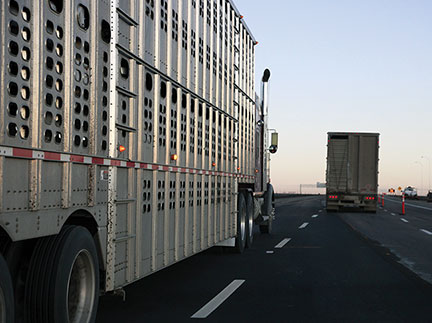
Photo credit: Lee Gunderson
Transportation Regulations
In Alberta, cattle (beef and dairy) must be transported in accordance with the provincial Animal Health Act, which requires all cattle be identified by an approved tag applied to the animal before it is moved from its farm of origin or before 10 months of age (whichever occurs first.) Under Alberta’s Livestock Identification and Commerce Act (LICA), Alberta cattle transported or driven within the province or to a destination outside the province must have the appropriate documentation accompanying the animals. Alberta’s delegated authority, Livestock Identification Services Ltd. (LIS), is responsible for all transportation documentation under LICA, including the Alberta Livestock Manifest, Livestock Permit and Special Permit.
Alberta Agriculture and Forestry’s approved Premises Identification (PID) Numbers are to be recorded on Alberta Livestock Manifests, Livestock Permits and Special Permits to assist with trace backs in a disease outbreak. On Alberta Livestock Manifests, livestock owners/dealers are to record the PID Number of where the livestock are being transported from and the receiver is to record the PID Number of the end destination.
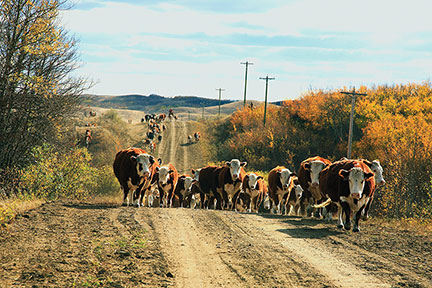
You do not need to fill out a manifest if you drive your animals on foot less than 30 kilometers to a destination that is not a community pasture, inspection site or forest reserve.
Photo credit: Lee Gunderson
Alberta Livestock Manifests
Alberta Livestock Manifests are used to document the movement of cattle. An Alberta Livestock Manifest is required to transport or drive cattle within Alberta and to inspection sites* unless the cattle meet the following conditions:
- accompanied by a Livestock Permit or, where applicable, a Special Permit;
- driven on foot less than 30 kilometers to a destination that is not a community pasture, inspection site or forest reserve; or
- transported within Alberta to receive veterinary services and are being returned to their point of origin after receiving these services.
Subject to the few exceptions listed above, you must complete an Alberta Livestock Manifest when transporting your cattle within Alberta.
A copy of each Alberta Livestock Manifest must be kept by the owner, the transporter and the person receiving the cattle for 10 years from the date the manifest is completed. Alberta Livestock Manifest books are supplied by LIS and are available throughout the province from LIS Field Offices, livestock (auction) markets and AF Field Offices.
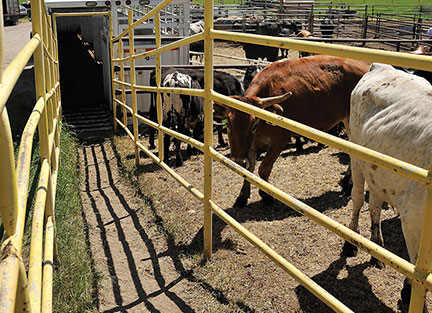
Photo credit: CGI Photography
Livestock Permits
Livestock Permits are issued by LIS Livestock Inspectors. All cattle transported or driven from an inspection site (other than a feedlot or an uninspected country sale) to a destination in Alberta, or from an originating point in Alberta to a destination outside Alberta, must be accompanied by a Livestock Permit unless:
- the cattle are being transported under a Special Permit (see next section for details) and are not being transported to an inspection site, or for sale or slaughter;
- the cattle are accompanied with an Alberta Livestock Manifest and are being transported to an approved inspection site in Saskatchewan or British Columbia where the cattle will be inspected upon arrival; or
- the requirement for a Livestock Permit has been waived by LIS in accordance with an exemption allowed under LICA. To learn about the exceptions under LICA, refer to the legislation at www.qp.alberta.ca.
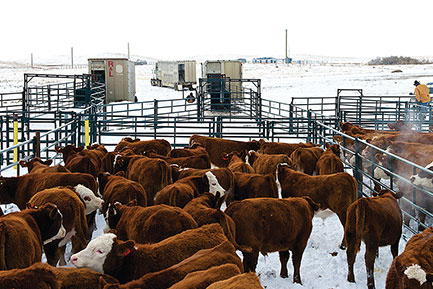
Livestock Permits are used to document the movement of livestock to a destination outside the province as well as when leaving an inspection site in Alberta.
Photo credit: CGI Photography
Livestock Permits authorize a single movement of livestock from the location where the animal was inspected to the destination described on the Livestock Permit. A Livestock Permit expires seven days after the date it was issued or when the cattle are delivered to their destination, whichever is earlier. A copy of each Livestock Permit must be kept by the owner, transporter, the person receiving the cattle and LIS for 10 years from the date the Livestock Permit is issued.
Special Permits
Special Permits are issued by LIS Livestock Inspectors and include Rodeo and Exhibition Permits and Pedigree Cattle Permits. Special Permits are used to transport rodeo, exhibition and pedigree cattle more than once in a calendar year, both within and outside Alberta. Designed as annual permits, Special Permits expire on December 31 of the year in which they are issued.
Special Permits cannot be used to transport cattle to an inspection site, or for sale or slaughter.
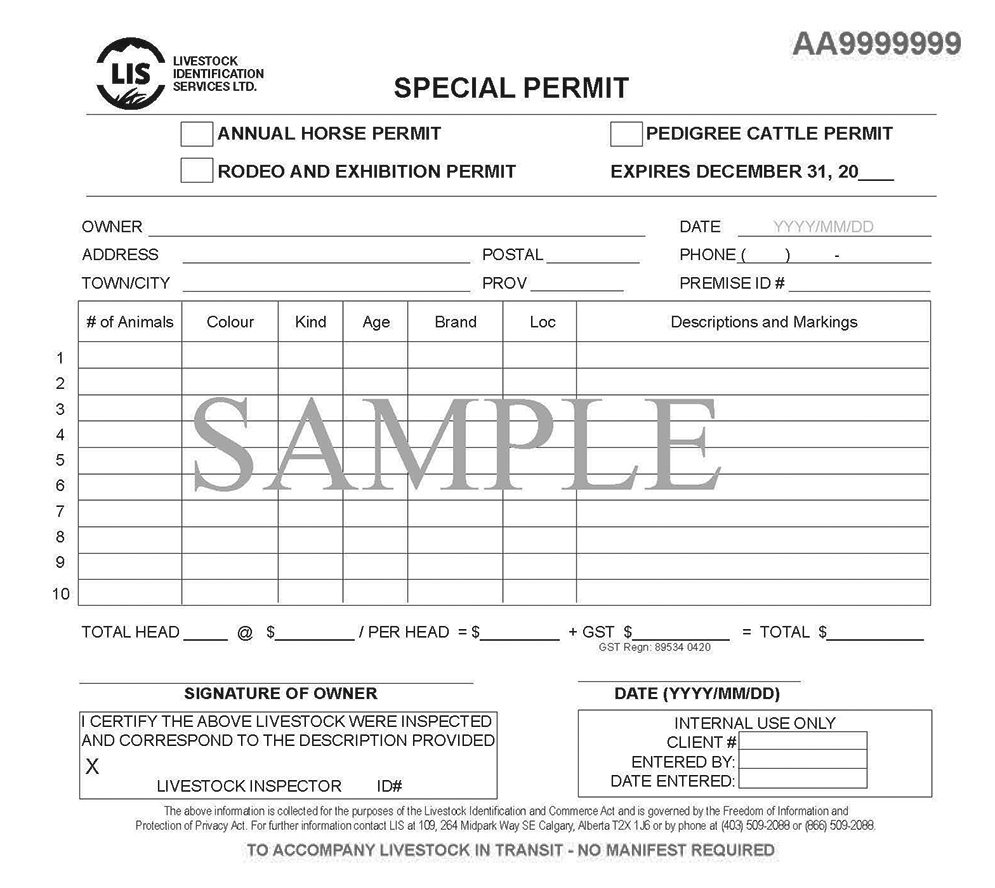
Transporting Out-of-province Cattle in Alberta
The Alberta Livestock Manifest and Livestock Permit requirements of LICA do not apply to persons who transport cattle into or through Alberta from an originating point outside Alberta so long as:
- the originating jurisdiction requires the cattle to be accompanied with documentation to be transported out of that jurisdiction; and
- the cattle are accompanied with that documentation.
The exemption that allows cattle to move into or through Alberta on out-of-province documentation expires when the cattle stop in Alberta for a purpose other than rest or when they are required to be inspected in Alberta.
If out-of-province cattle stop in Alberta for a purpose other than rest, the location where the cattle stop should be considered the originating point when completing an Alberta Livestock Manifest or requesting a Livestock Permit.
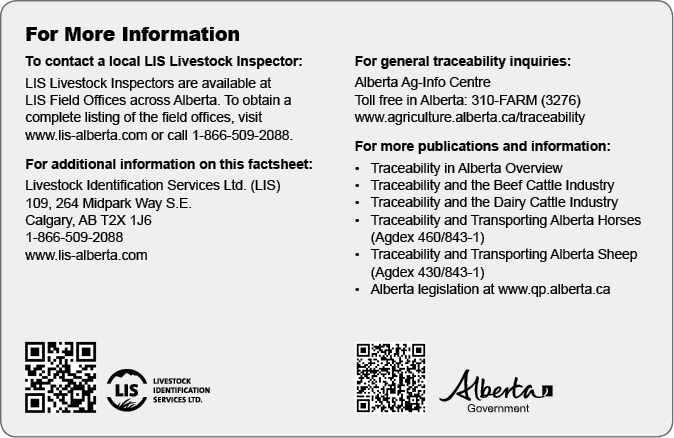
*Inspection sites are livestock markets, feedlots, livestock assembly stations, abattoirs and country sale sites.
Source: Agdex 420/843-2. September 2013. |
|